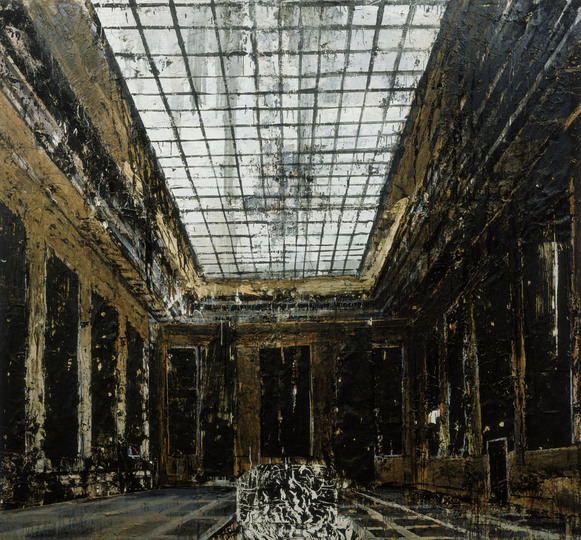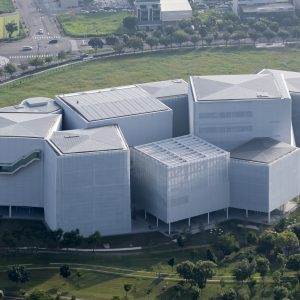27th September – 14th December 2014 Sponsored by
The Royal Academy of Arts is to present the first major retrospective of Anselm Kiefer’s work to be held in the UK. Considered to be one of the most important artists of his generation, the exhibition will span over forty years from Kiefer’s early career to the present time, bringing together artwork from international private and public collections. The exhibition will be arranged chronologically, presenting the epic scale of his artwork and the breadth of media he has used throughout his career, including painting, sculpture, photography and installation. Kiefer has also created a number of works conceived specifically for the Royal Academy’s Main Galleries, showcasing his continued interest in seeking new challenges and producing ever more ambitious artwork.

Anselm Kiefer, Ages of the World, 2014 Private collection
Photo courtesy Royal Academy of Arts. Photography: Howard Sooley / © Anselm Kiefer.
Kiefer’s fascination with history itself and with the work of past masters permeates his subject matter. From mythology, to the Old and New testaments, Kabbalah, alchemy, philosophy and the poetry of Paul Celan and Ingeborg Bachmann, Kiefer’s work wrestles with the darkness of German history and considers the complex relationship between art and spirituality. His technical use of materials such as clay, ash, earth, lead, fabric and dried flowers amongst others, adds further symbolism and depth to his work.

Anselm Kiefer Interior (Innenraum), 1981 Oil, acrylic, and paper on canvas, 287.5 x 311 cm Collection Stedelijk Museum, Amsterdam Photo Collection Stedelijk Museum / © Anselm Kiefer
Highlights of the exhibition include photographs and paintings from the controversial Occupations and Heroic Symbols (Heroische Sinnbilder) series of the late 1960s and early 1970s. These images record Kiefer’s re-enactment of the Nazi salute in locations across Europe, made in the belief that one must confront rather than supress the experiences of history. A series of paintings from Kiefer’s Attic series will also be exhibited, including Father, Son and the Holy Ghost (Vater, Sohn, Heiliger Geist), 1973 and Notung, 1973 depicting powerful renderings of wooden interior spaces based on the studio space that Kiefer was occupying in Walldürn-Hornbach in south-west Germany, which he has referred to as “a place to teach myself history.” The exhibition will also feature his monumental architectural paintings, such as To the Unknown Painter (Dem unbekannten Maler), 1983 that reflect on the neo-classicist buildings of Albert Speer, Hitler’s architect, and the role of the artist in considering collective memory.
The exhibition will consider the key themes and the diverse, personal iconography that Kiefer has created in his work over the years and will look at the influence of place on his oeuvre. As he said in a recent interview, “Art is an attempt to get to the very centre of truth. It never can, but it can get quite close.”
Other paintings on display include Palette on a Rope (Palette am Seil), 1971 that uses the motif of the artist’s palette to represent Kiefer’s engagement with the facets of history, as well as a series of early watercolours including From Oscar Wilde (Von Oskar Wilde),1974 and Winter Landscape (Winterlandschaft), 1970.
Anselm Kiefer will also present his celebrated lead books, including the paintings For Paul Celan, Ash Flowers (Für Paul Celan, Aschenblume), 2006 and Black Flakes (Schwarze Flocken), 2006. Kiefer’s new works for the exhibition will incorporate a number of large-scale paintings and sculptures, including a major installation for the Royal Academy’s courtyard.
Kathleen Soriano, Director of Exhibitions says,
“While particular segments of Kiefer’s oeuvre have been shown at galleries in this country at intervals over recent decades, never before has a comprehensive overview taken place in spaces befitting the monumental character of many of his pieces. This is an unprecedented opportunity to consider and re-evaluate the trajectory of Kiefer’s practice and the importance of his innovations and contributions to the history of art, whilst celebrating one of our own Honorary Royal Academicians.”
About The Artist
Anselm Kiefer was born in 1945 in Donaueschingen, Germany. After studying law, he began his art education in Karlsruhe and then Düsseldorf, representing Germany at the 39th Venice Biennale in 1980. His work has been collected by and shown at major museums throughout the world including MoMA, New York; The Art Institute of Chicago; Philadelphia Museum of Art (1987); Neue Nationalgalerie, Berlin (1991); The Metropolitan Museum, New York (1998); Fort Worth Museum of Art (2005); the San Francisco Museum of Modern Art (2006); Louisiana Museum of Art, Denmark (2010); Guggenheim Museum, Bilbao; Tel Aviv Museum of Art; the Grand Palais, Paris; The Rijksmuseum, Amsterdam (2011) and Mass MoCA, Massachusetts (2013). In 2007 Kiefer became the first living artist to be commissioned to install a permanent work in the Louvre, Paris since Georges Braque some 50 years earlier. In this same year he created the first Monumenta installation for the Grand Palais, Paris. Kiefer has lived and worked in France since 1993. He was elected an Honorary Member of the Royal Academy of Arts in 1996 and was awarded the Praemium Imperiale in 1999. In 2005 he was presented with the Federal Cross of Merit, First Class, and the Austrian Decoration for Science and Art; in 2008 the Peace Prize of the German Book Trade; in 2011 a Commandeur dans l’Ordre des Arts et des Lettres by the French Ministry of Culture. 2010 saw his appointment at the Chair of Artistic Creation at the renowned Collège de France, Paris where he delivered nine lectures entitled Art will survive its ruins (Die Kunst geht knapp nicht unter).
Further Reading:
Interview with Anselm Kiefer, ahead of his Royal Academy show FT.com
Britain’s Royal Academy Surveys Anselm Kiefer’s Work: Wall Street Journal
Inside Anselm Kiefer’s astonishing 200-acre art studio: The Guardian
Anselm Kiefer Is Trying to Buy a Nuclear Power Plant: New York Observer








